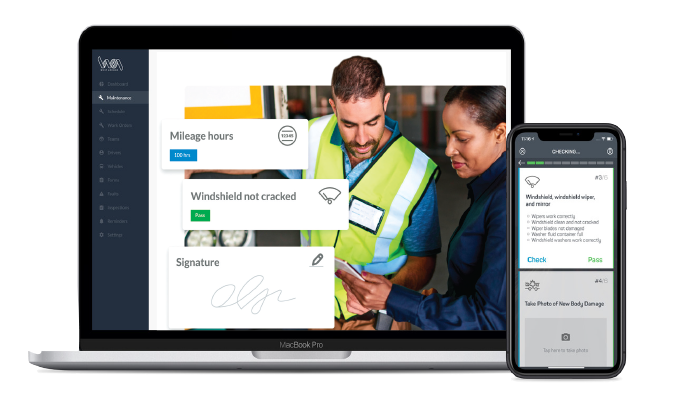By Tim Boyle
Paper forms have dominated fleet vehicle inspections and maintenance for years. While tasks such as daily or annual inspections are a compliance requirement for vehicles operating under a DOT number, technology is changing how contractors manage all of their assets.
While many companies still rely on two-ply forms for inspections or paper work orders for maintenance, it’s important to understand the advances in technology from the past 20 years. As the way we work changes—with more remote employees and jobs—only technology can ensure we stay connected and safe in an ever-increasing regulatory environment.
Here are seven ways technology has changed—and continues to change—not only the way you inspect or service your trucks, but the equipment and assets employees depend on every day.
1. SENSORS & TELEMATICS DATA
Depending on the thoroughness of a vehicle inspection, managers and fleet operators can automatically report data related to tire pressure readings (for example) during a pre- or post-trip inspection through the use of telematics solutions.
Whether installed in commercial or consumer work trucks, solutions like Geotab and Verizon Connect also integrate with digital DVIR solutions like Whip Around to make it easier to bring in vehicle information such as GPS location or an automatic odometer reading for inspection purposes.
Leveraging data from tire pressure sensors, oil pressure sensors, and others have made these measurements easier than ever, assuming these systems are regularly serviced.
2. AUTOMATED MAINTENANCE REMINDERS
Electronic data collects through the use of inspection and maintenance tools. One way this advances maintenance is through the use of reminders. Especially with a fleet of trucks on numerous jobsites, determining when routine maintenance tasks should be performed is something that technology can remind managers to complete.
One example of this is a simple alert triggered from an odometer reading.
3. COMMUNICATION BETWEEN DRIVERS, MANAGERS, & MECHANICS
The way organizations operate has undoubtedly changed in response to the coronavirus, and this includes how information is communicated between drivers, managers, and even mechanics. What used to be a primarily paper-based inspection and maintenance process has quickly evolved into an entirely digital and contactless process for a growing number of companies.
One example of this is the introduction to safety protocols many companies built into the pre-trip and post-trip inspection process. Disinfecting surfaces and making sure essentials like hand sanitizers are available and stocked at all times is a simple inspection item that can make a big difference.

4. ENTERING NOTES DIGITALLY INCLUDING ANY IMAGES OF DAMAGE
Undocumented damage really can take its toll on jobsites depending on what type of equipment trucks are exposed to.
While many still revert to paper accident forms, entering notes digitally and taking photos of damage can help protect employees who otherwise may be blamed for damage they did not cause.
5. INVENTORY MANAGEMENT FOR PARTS
Especially with smaller contractors using in-house mechanics, another way technology can help reduce unused inventory is by implementing inventory management for parts work trucks or equipment depend on.
Technology such as reorder notifications when tires are low in stock or simply having an accurate count of inventory on hand helps companies stay on budget by reducing over purchasing.
6. BUDGETING & RESALE VALUE
A not-so-obvious benefit vehicle inspection and maintenance software has afforded work truck fleets relates to budgeting. Projecting the annual costs of maintenance over time becomes much easier with more vehicle data and can even help in spotting common occurrences based on the vehicle manufacturer.
This type of data can not only enable organizations to be more accurate, but also make better purchasing decisions. For example, an organization may realize upgrading to Ford F-250s may be the best data-driven decision over time to avoid common problems that are linked to their fleet of light-duty trucks.
7. DIGITAL WORK ORDERS
Creating work orders is simple enough most of the time, but it’s making sure work orders are delivered to mechanics in a timely manner that technology can really assist with.
Instant visibility into vehicle faults whenever they occur allows maintenance teams to be proactive in tasks like ordering parts. This is not possible if work orders are hand delivered at the end of a shift.
TAKING ADVANTAGE
Since there are so many different ways to implement processes internally, it’s best to start small with an existing process like inspections you would like to streamline or modernize.
While GPS tracking and other telematics solutions can be installed and provide more data to enable fleets to save on fuel costs or maintenance, getting team members to replace paper processes with a mobile app is usually a good starting point.
These types of maintenance and inspection solutions also don’t require any hardware or extensive training to use, making it easy for teams using paper inspections to get started right away.
ABOUT THE AUTHOR
Tim Boyle is the cofounder of Whip Around, a fleet compliance and maintenance software application for the US transport industry. Reach him at tim.boyle@whiparound.com. Find out more, visit www.whiparound.com.




